- Established 1982 -HOME: www.hiltonpond.org
THIS WEEK at HILTON POND Subscribe for free to our award-winning nature newsletter (Back to Preceding Week; on to Next Week) |
SOLVING THE MYSTERY OF AN So far as Ruby-throated Hummingbirds (RTHU) are concerned, spring has sprung VERY slowly--one of the slowest starts in our 36 years of hummer research at Hilton Pond Center. As always, we hung our first complement of eight feeders on St. Patrick's Day, That said, there HAVE been a few BANDED Ruby-throated Hummingbirds frequenting the Center's feeders in 2019, the first being a male recaptured on 2 April; we banded him here last August as a recent fledgling. On 17 April we recaptured our first white-throated female of the season (see photo below, and note the band); she was already an adult when we banded her locally last June. A much older female RTHU entered a trap on 26 April, having been caught as an adult in June 2016 and recaptured each year since--making her an after-4th-year individual in at least her fifth year of existence! She's an excellent example of site fidelity.
All text, maps, charts & photos © Hilton Pond Center When people find out we study hummingbirds by capturing them and putting metal bands on their legs, a frequently heard question is whether it’s possible to see a band on a hummingbird at a feeder. The answer is a qualified "yes." We offer as evidence the photo below taken on Earth Day 2019 (22 April) of an adult male Ruby-throated Hummingbird perched on a saucer-style feeder just outside our office window at Hilton Pond Center. (We hope you can view this image on something other than a cell phone for details. Those are tiny rain droplets on his crown.) Check out that red gorget!
All text, maps, charts & photos © Hilton Pond Center The photo also reveals a glint of metal on the bird’s left leg, a thin strip of aluminum we know from experience has a letter and five digits inscribed thereon. This minuscule ring weighs about 0.6-0.7 milligrams--less than one-thousandth of a gram--roughly equivalent to a small wristwatch or a gold signet ring on an adult human’s finger. In fact, the band may weigh less than one of the hummingbird’s tail feathers! (In the photo below, that's 300 hummer bands photoengraved on a 4" x 6" sheet!) Ornithologists believe this super-lightweight metal ring has insignificant effect on a hummer’s well-being or longevity; as evidence, we’ve had many ruby-throats return to Hilton Pond year after year after year. (One geriatric RTHU came back seven years in a row after banding!)
All text, maps, charts & photos © Hilton Pond Center This year's male RTHU in the photo above was a wily one that made frequent feeder visits but had yet to enter one of our traps; it was almost certain he was banded in a previous year. We further suspect he was caught at Hilton Pond because the band was on his LEFT leg. We band all males on the left and all females on the right. (Most banders put bands on all their birds’ right legs for a simple reason: The right leg is easier to reach for right-handed banders, but left-handers are more likely to band everything on the left.) Even though you can indeed see a band on the hummingbird’s left leg, chances of your reading his number or one on a hummer at your own feeder are quite slim. However, if the bird sits just right on a feeder in good light and close enough, you may be able to take a series of photos that reveal the number sequence as the band rotates around the leg in successive visits. That was our goal with this particular hummer that seemed unwilling to be re-trapped for band number verification.
All text, maps, charts & photos © Hilton Pond Center As shown above, we set up a Canon 70D SLR camera and 100mm macro lens on a small tripod atop our office desk to see if we could photograph the band--all in hopes of reading the inscription. As part of our hummingbird research, we were intensely interested to know the band number so we could determine if and when we caught the hummer in a past year or--because near-miracles sometimes do occur--if he had been banded elsewhere by someone else before showing up at Hilton Pond.
All text, maps, charts & photos © Hilton Pond Center After some effort on 23 April we were able to get the shot above of the bird, his band positioned so we could read the last three numerals: 268. With nearly 6,200 Ruby-throated Hummingbirds banded at Hilton Pond through the years, we’ve had several band sequences that included 268 as the last three numbers, (In more recent years we used 268-ending bands on male RTHU in 2011, 2015, and 2018.) However, because other hummer banders also could have used that sequence, we didn't jump to any conclusions. With other duties calling, we put the camera away, biding our time until another day when we might get a photo of the band in a slightly different position that revealed a letter and/or additional numerals. On the morning of 24 April the RTHU in question started visiting a different port at the saucer-style window feeder, offering a new angle from which to photograph. After numerous exposures we finally got an image (below) that revealed his band number began with “M0.” Sure enough, last year on 5 June we banded an adult male Ruby-throated Hummingbird that received band number that began M08 and ended 268.
All text, maps, charts & photos © Hilton Pond Center Even though we had not yet seen a first “8” on this hummer’s band, we were 99% confident the bird in question was the one from 2018—if only because we've demonstrated hundreds of times how banded RTHU return to Hilton Pond in subsequent years. That said, there was still that 1% chance this bird’s band did NOT bear the “missing numeral 8” and was first captured by someone else. For the sake of scientific accuracy, we continued trying to get a photo that confirmed this M0?268 was indeed the Ruby-throated Hummingbird we banded last year--well before it flew off to the Neotropics and came back again in 2019 for a Hilton Pond reunion.
Our photographic efforts to identify this hummer were productive and close to 100% accurate, but having the bird in hand to verify he was M08268 was undeniable evidence. This male, banded last year as an adult, almost certainly went off to Central America in autumn and returned half a year later to our little 11-acre compound, possibly as far as 1,500 miles from his wintering grounds. (See RTHU range map below.)
All text, maps, charts & photos © Hilton Pond Center But how could we be positively be sure the bird we'd been photographing at the feeder was also the bird we had just caught? We have a way, and we used it--a patch of dark green temporary dye applied to the bird's upper breast. The U.S. Bird Banding Laboratory authorizes Hilton Pond Center and Operation RubyThroat to band Ruby-throated Hummingbirds--a special permit not held by all bird banders. We also have permission to color mark RTHU, using non-toxic green dye on birds captured locally. We started this protocol to keep from recapturing the same hummingbird repeatedly in our pull-string and electronic traps. The dye is harmless and washes off or fades in about four weeks but while present allows us to see an already banded ruby-throat. The hummingbird band is essentially invisible from a distance, but by spotting the green dye we know not to set off a trap over and over and over again for the same individual--thereby lessening any unnecessary handling of our study species.
All text, maps, charts & photos © Hilton Pond Center When we finally recaptured M08268, we weighed him (2.86g), measured him (wing 38.68mm, tail 16mm, culmen 16mm), and dabbed a little green felt tip dye on his upper breast before release. Sure enough, when we watched the window feeder a little while later, a banded and color-marked adult male Ruby-throated Hummingbird came in to drink (see photo above)--and we now knew exactly who he was. Mystery solved! All text, maps, charts & photos © Hilton Pond Center
All text, maps, charts & photos © Hilton Pond Center POSTSCRIPT: We color mark with green every Ruby-throated Hummingbird we band at Hilton Pond Center, but not all these birds hang around very long--especially during migration. Therefore, it's entirely possible if you live north of York SC you could see one of "our" hummers some spring on its way northward. Likewise, if you're south of us a green-marked RTHU could appear at your feeder in fall. (The mark is easy to see on young males and females like the one above, more difficult to discern on an adult male with his dark flanks and red gorget.) Since you may not be able to duplicate our camera set-up for photographing and reading hummingbird bands, you can still perform a valuable role by immediately reporting any color marked hummer to us at RESEARCH. Get a photo of the bird with color mark if you can! It's possible we can contact an authorized hummingbird bander near you who might recapture the bird and read its number. There have been relatively few Ruby-throated Hummingbirds encountered away from their original banding sites. Thus, even without recapture your sighting and timely report could be very significant, so please keep your eyes peeled for color marks. (Incidentally, other hummingbird banders use different color marking protocols, including dots on the crown and back. You can also report sightings of these birds to us at Hilton Pond.) All text, maps, charts & photos © Hilton Pond Center
Checks also can be sent to Hilton Pond Center at: All contributions are tax-deductible on your Don't forget to scroll down for Nature Notes & Photos, |
|---|
|
"This Week at Hilton Pond" is written and photographed by Bill Hilton Jr., executive director of Hilton Pond Center for Piedmont Natural History
|
|
|
Please refer "This Week at Hilton Pond" to others by clicking on this button: |
|

 anticipating the first ruby-throats sometime during the last week in March.
anticipating the first ruby-throats sometime during the last week in March. 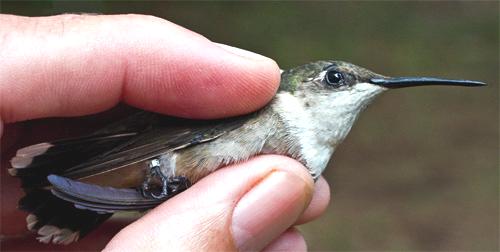
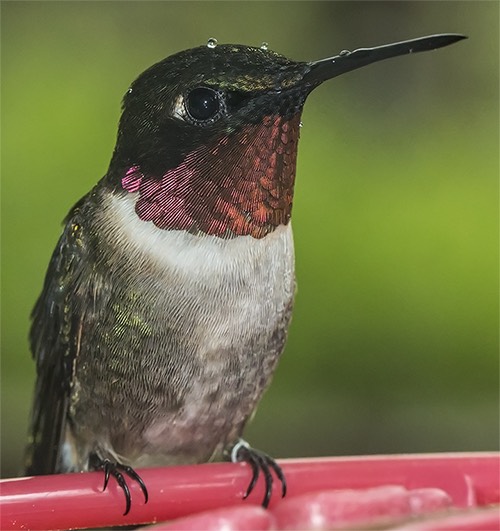

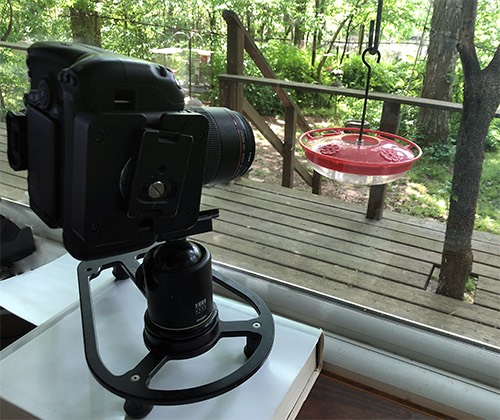
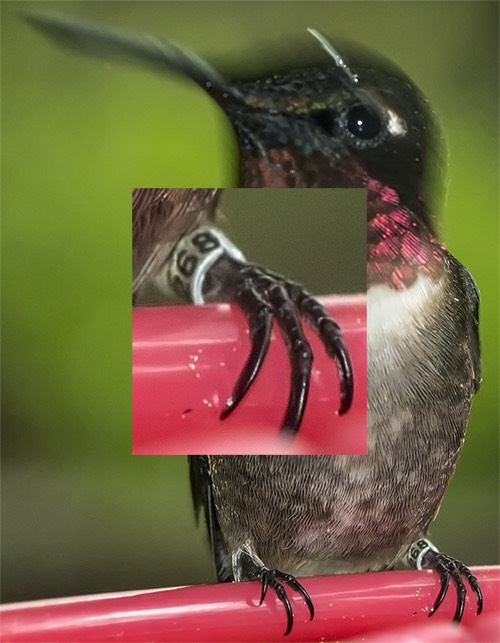
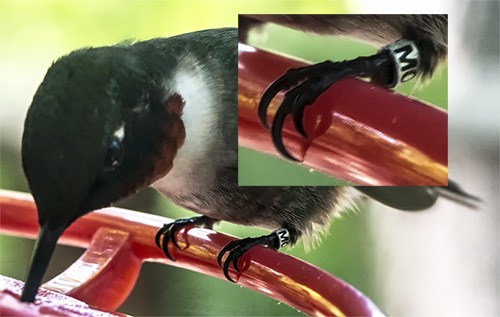
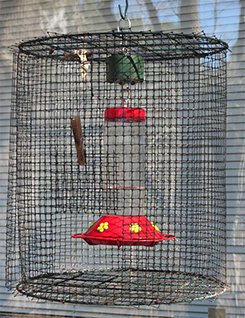 Later in the day on the 24th we gazed out our office window and saw a hummingbird enter one of our Dawkins-style cylinder traps baited with sugar water
Later in the day on the 24th we gazed out our office window and saw a hummingbird enter one of our Dawkins-style cylinder traps baited with sugar water 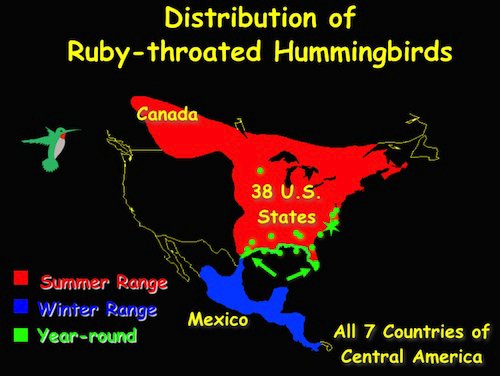
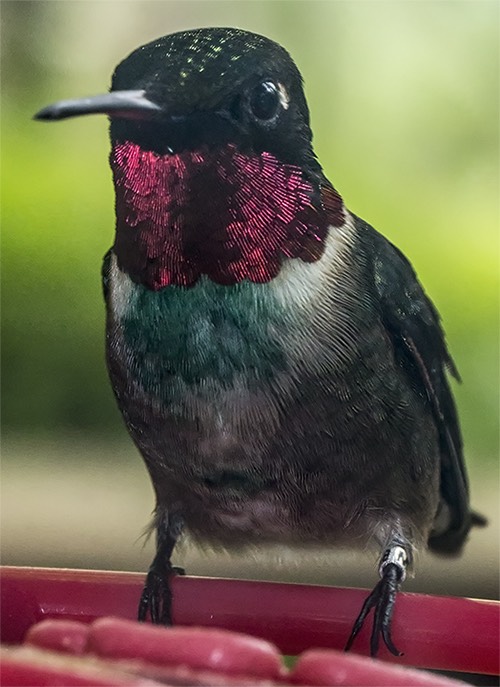
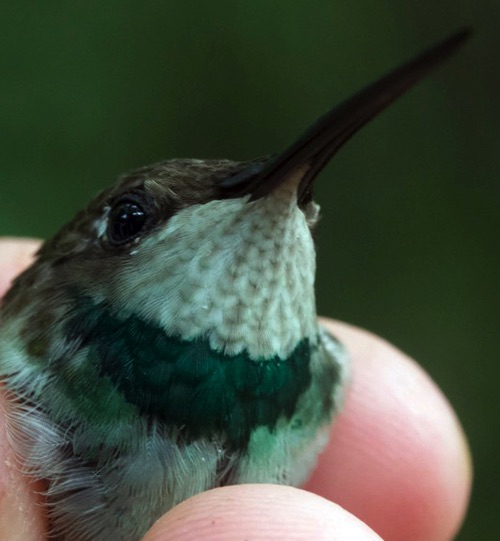



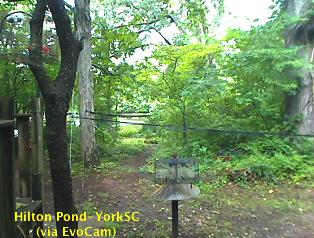


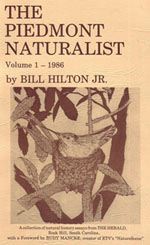



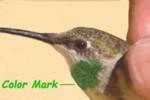 Please report your
Please report your